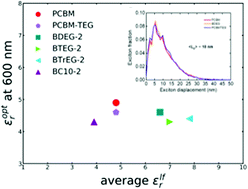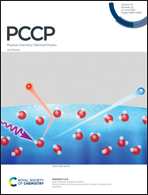Investigating the dielectric properties and exciton diffusion in C70 derivatives†
Abstract
In recent years, the dielectric constant (εr) of organic semiconductors (OSCs) has been of interest in the organic photovoltaic (OPV) community due to its potential influence on the exciton binding energy. Despite progress in the design of high εr OSCs and the accurate measurement of the εr, the effects of the synthetic strategies on specific (opto)electronic properties of the OSCs remain uncertain. In this contribution, the effects of εr on the optical properties of five new C70 derivatives and [70]PCBM are investigated. Together with [70]PCBM, the derivatives have a range of εr values that depend on the polarity and length of the side chains. The properties of the singlet excitons are investigated in detail with steady-state and time-resolved spectroscopy and the exciton diffusion length is measured. All six derivatives show similar photophysical properties in the neat films. However, large differences in the crystallinity of the fullerene films influence the exciton dynamics in blend films. This work shows that design principles for OSCs with a higher εr can have a very different influence on the performance of traditional BHJ devices and in neat films and it is important to consider the neat film properties when investigating the optoelectronic properties of new materials for OPV.



 Please wait while we load your content...
Please wait while we load your content...